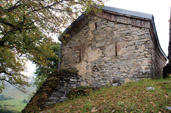Masons at Work
David Khoshtaria
George Chubinashvili National Research Centre for Georgian Art History and Heritage Preservation

David Khoshtaria
George Chubinashvili National Research Centre for Georgian Art History and Heritage Preservation
Medieval Architectural Design and Building Process According to the Sculptural Images in Korogo Church
A small church located near the mountain village of Korogo (Georgia) dates from the late 10th century. Being very modest in its architecture, the church has an unusually rich sculptural decoration. In the northern entrance of the church, there is a reused stone with a relief showing a donor holding an oblong rectangular object on the surface of which a plan of a building is incised. At its upper end, which apparently corresponds to the east side, the drawing is rounded in the form of a trefoil. Is this the plan of the existing building? The church at Korogo has a peculiar layout. Covered with a gable roof, it looks like a single-nave structure from the outside. However, in the interior its western part is divided into two naves, and the sanctuary is tripartite. Being rectangular in plan, all three parts of the sanctuary are covered with conches. The plan carved on the stone relief shows these three conches on the east by means of curves in the form of a trefoil. Thus, though it is not an exact plan of the existing building, it represents some of its characteristics in a peculiar way combining a schematic ground plan and the projection of vaulting. Of course, it must be taken into consideration that we observe not a working drawing itself, but its sculptural representation that does not aim at showing details.
The image is a telling argument in favor of the opinion that the idea of a drawn plan was familiar not only to Medieval builders and donors, but also to broader social groups—at least in this region. And naturally, this leads us to the question concerning the application of drawings in the Middle Ages. Did Medieval Georgian builders use drawings? Judging by the sculpture from Korogo, one can say: most probably yes, they did.
On its eastern façade, the Korogo church has a high cornice completely covered with sculptural images representing various stages of construction such as quarrying, transporting stones on sledges or on the backs of laborers, mixing mortar, hewing stone block, etc. In the scenes showing work in process emphasis is on the transportation of building materials. Taking into account the location of the church on the top of the mountain that would be a major effort.
Sculptural images of the Korogo church provide a valuable source of information concerning the methods of medieval builders. They are especially important as they have no parallels in Byzantine art.
The image is a telling argument in favor of the opinion that the idea of a drawn plan was familiar not only to Medieval builders and donors, but also to broader social groups—at least in this region. And naturally, this leads us to the question concerning the application of drawings in the Middle Ages. Did Medieval Georgian builders use drawings? Judging by the sculpture from Korogo, one can say: most probably yes, they did.
On its eastern façade, the Korogo church has a high cornice completely covered with sculptural images representing various stages of construction such as quarrying, transporting stones on sledges or on the backs of laborers, mixing mortar, hewing stone block, etc. In the scenes showing work in process emphasis is on the transportation of building materials. Taking into account the location of the church on the top of the mountain that would be a major effort.
Sculptural images of the Korogo church provide a valuable source of information concerning the methods of medieval builders. They are especially important as they have no parallels in Byzantine art.


